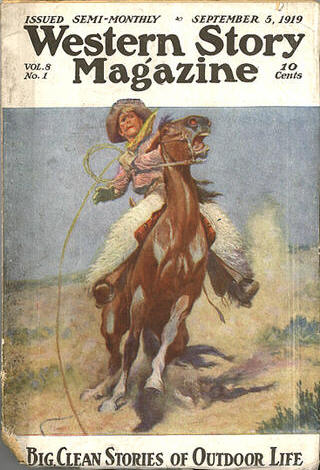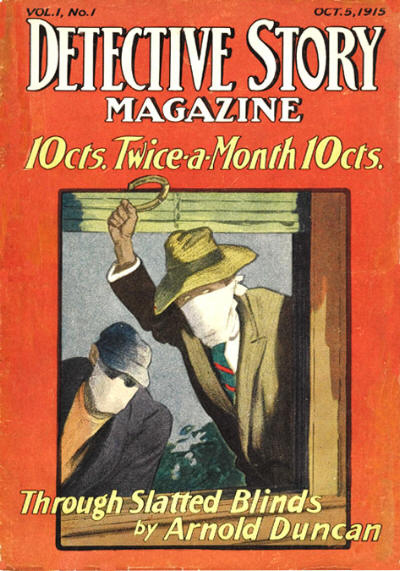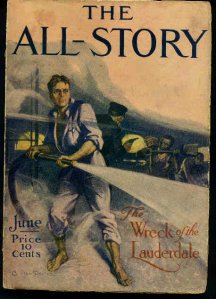|
Dime Novel
The dime novel is a form of late 19th-century and early 20th-century U.S. popular fiction issued in series of inexpensive paperbound editions. The term ''dime novel'' has been used as a catchall term for several different but related forms, referring to story papers, five- and ten-cent weeklies, "thick book" reprints, and sometimes early pulp magazines.The English equivalents were generally called penny dreadfuls or shilling shockers. The German and French equivalents were called "Groschenromane" and "livraisons à dix centimes", respectively. American firms also issued foreign editions of many of their works, especially as series characters came into vogue. The term was used as a title as late as 1940, in the short-lived pulp magazine ''Western Dime Novels''. In the modern age, the term ''dime novel'' has been used to refer to quickly written, lurid potboilers, usually as a pejorative to describe a sensationalized but superficial literary work. History In 1860, the publ ... [...More Info...] [...Related Items...] OR: [Wikipedia] [Google] [Baidu] |
Seth Jones
Seth Jones may refer to: * Seth Jones (political scientist) (born 1972), American political scientist *Seth Jones (ice hockey) Jared Seth Jones (born October 3, 1994) is an American professional ice hockey defenseman and an alternate captain for the Chicago Blackhawks of the National Hockey League (NHL). He was selected fourth overall by the Nashville Predators in the ... (born 1994), American ice hockey defenseman *'' Seth Jones'', a dime novel by Edward S. Ellis, in the E. F. Beadle series of the Beadle Company {{disambiguation Jones, Seth ... [...More Info...] [...Related Items...] OR: [Wikipedia] [Google] [Baidu] |
New York Weekly
The ''New York Weekly'' was a story newspaper published from 1858–1910 in New York City. Under related names it was published from 1846–1915. The paper had its origins in 1846 as the ''New York Dispatch'' (1846–1854), and ''New York Weekly Dispatch'' (1855–1858), with Amor J. Williamson as proprietor.(2 March 1867)Obituary - Mr. Amor J. Williamson ''The New York Times'' and was purchased by Francis Shubael Smith and Francis Scott Street in 1858. Smith was an editor at the ''Dispatch'' and Street a bookkeeper, and they paid $40,000 for the ownership of the paper (paying nothing up front, but paying it off within 5 years). From 1910-15 it was published as the ''New York Weekly Welcome''.Dime Novel Companion, The: A Source Book: A Source Book ... [...More Info...] [...Related Items...] OR: [Wikipedia] [Google] [Baidu] |
Library Of Congress
The Library of Congress (LOC) is the research library that officially serves the United States Congress and is the ''de facto'' national library of the United States. It is the oldest federal cultural institution in the country. The library is housed in three buildings on Capitol Hill in Washington, D.C.; it also maintains a conservation center in Culpeper, Virginia. The library's functions are overseen by the Librarian of Congress, and its buildings are maintained by the Architect of the Capitol. The Library of Congress is one of the largest libraries in the world. Its "collections are universal, not limited by subject, format, or national boundary, and include research materials from all parts of the world and in more than 470 languages." Congress moved to Washington, D.C., in 1800 after holding sessions for eleven years in the temporary national capitals in New York City and Philadelphia. In both cities, members of the U.S. Congress had access to the sizable colle ... [...More Info...] [...Related Items...] OR: [Wikipedia] [Google] [Baidu] |
The Boy Nihilist, By Allan Arnold In Pluck And Luck June 16 1909
''The'' () is a grammatical article in English, denoting persons or things that are already or about to be mentioned, under discussion, implied or otherwise presumed familiar to listeners, readers, or speakers. It is the definite article in English. ''The'' is the most frequently used word in the English language; studies and analyses of texts have found it to account for seven percent of all printed English-language words. It is derived from gendered articles in Old English which combined in Middle English and now has a single form used with nouns of any gender. The word can be used with both singular and plural nouns, and with a noun that starts with any letter. This is different from many other languages, which have different forms of the definite article for different genders or numbers. Pronunciation In most dialects, "the" is pronounced as (with the voiced dental fricative followed by a schwa) when followed by a consonant sound, and as (homophone of the archaic pr ... [...More Info...] [...Related Items...] OR: [Wikipedia] [Google] [Baidu] |
The Liberty Boys Running The Blockade, By Harry Moore - April 7 1922
''The'' () is a grammatical article in English, denoting persons or things that are already or about to be mentioned, under discussion, implied or otherwise presumed familiar to listeners, readers, or speakers. It is the definite article in English. ''The'' is the most frequently used word in the English language; studies and analyses of texts have found it to account for seven percent of all printed English-language words. It is derived from gendered articles in Old English which combined in Middle English and now has a single form used with nouns of any gender. The word can be used with both singular and plural nouns, and with a noun that starts with any letter. This is different from many other languages, which have different forms of the definite article for different genders or numbers. Pronunciation In most dialects, "the" is pronounced as (with the voiced dental fricative followed by a schwa) when followed by a consonant sound, and as (homophone of the archaic pr ... [...More Info...] [...Related Items...] OR: [Wikipedia] [Google] [Baidu] |
Western Story Magazine
''Western Story Magazine'' was a pulp magazine published by Street & Smith, which ran from 1919 to 1949.Doug Ellis, John Locke, and John Gunnison, (editors),''The Adventure House Guide to the Pulps'', Adventure House, 2000. (pp. 311–12). It was the first of numerous pulp magazines devoted to Western fiction. In its heyday, ''Western Story Magazine'' was one of the most successful pulp magazines; in 1921 the magazine was selling over half a million copies each issue.Ed Hulse, ''The Blood 'n' Thunder Guide to Collecting Pulps''. Murania Press, 2009. (pp. 137–141) The headquarters was in New York City. History ''Western Story Magazine'' began when Street & Smith executive Henry Ralston decided to convert one of the company's nickel weeklies, ''New Buffalo Bill Weekly'', into a pulp. Ralston installed Frank Blackwell as editor of the new magazine. The magazine attracted a number of famous Western authors, including Charles Alden Seltzer, H. Bedford-Jones, Stewart Edward White, ... [...More Info...] [...Related Items...] OR: [Wikipedia] [Google] [Baidu] |
Detective Story Magazine
''Detective Story Magazine'' was an American magazine published by Street & Smith from October 15, 1915, to Summer, 1949 (1,057 issues). It was one of the first pulp magazines devoted to detective fiction and consisted of short stories and serials. While the publication was the publishing house's first detective-fiction pulp magazine in a format resembling a modern paperback (a "thick book" in dime-novel parlance), Street & Smith had only recently ceased publication of the dime-novel series '' Nick Carter Weekly'', which concerned the adventures of a young detective. From February 21, 1931, to its demise, the magazine was titled ''Street & Smith's Detective Story Magazine''. During half of its 34-year life, the magazine was popular enough to support ''weekly'' issues. Ludwig Wittgenstein, the eminent philosopher, was among the magazine's readership. [...More Info...] [...Related Items...] OR: [Wikipedia] [Google] [Baidu] |
Argosy (magazine)
''Argosy'', later titled ''The Argosy'', ''Argosy All-Story Weekly'' and ''The New Golden Argosy'', was an American pulp magazine from 1882 through 1978, published by Frank Munsey until its sale to Popular Publications in 1942. It is the first American pulp magazine. The magazine began as a children's weekly story–paper entitled ''The Golden Argosy''. In the era before the Second World War, ''Argosy'' was regarded as one of the "Big Four" pulp magazines (along with '' Blue Book'', ''Adventure'' and '' Short Stories''), the most prestigious publications in the pulp market, that many pulp magazine writers aspired to publish in. Lee Server, ''Danger Is My Business: an illustrated history of the Fabulous Pulp Magazines''. San Francisco: Chronicle Books. (1993) (pp. 22-6, 50) John Clute, discussing the American pulp magazines in the first two decades of the twentieth century, has described ''The Argosy'' and its companion ''The All-Story'' as "the most important pulps of their er ... [...More Info...] [...Related Items...] OR: [Wikipedia] [Google] [Baidu] |
Fame And Fortune Weekly
''Fame and Fortune Weekly: Stories of Boys Who Make Money'' (1905–1929) was an American periodical for children published by Frank Tousey in New York. History and profile The magazine was started in 1905 with the name ''Fame and Fortune Weekly''. The first issue appeared on October 6, 1905. The magazine was redesigned as a pulp magazine and renamed as ''Fame and Fortune Magazine'' in October 1928. The frequency of the magazine was also switched to biweekly in 1928. Then it was renamed as ''Fortune Story Magazine'' in July 1929 and ended publication in December of that year. References External links University of South Florida Libraries: Fame and Fortune WeeklyFame and Fortune Weekly issues at Gutenberg''Fame and Fortune Weekly''at LibriVox LibriVox is a group of worldwide volunteers who read and record public domain texts, creating free public domain audiobooks for download from their website and other digital library hosting sites on the internet. It was founded in 2005 ... [...More Info...] [...Related Items...] OR: [Wikipedia] [Google] [Baidu] |
Secret Service COLOR
Secrecy is the practice of hiding information from certain individuals or groups who do not have the "need to know", perhaps while sharing it with other individuals. That which is kept hidden is known as the secret. Secrecy is often controversial, depending on the content or nature of the secret, the group or people keeping the secret, and the motivation for secrecy. Secrecy by government entities is often decried as excessive or in promotion of poor operation; excessive revelation of information on individuals can conflict with virtues of privacy and confidentiality. It is often contrasted with social transparency. Secrecy can exist in a number of different ways: encoding or encryption (where mathematical and technical strategies are used to hide messages), true secrecy (where restrictions are put upon those who take part of the message, such as through government security classification) and obfuscation, where secrets are hidden in plain sight behind complex idiosyncrati ... [...More Info...] [...Related Items...] OR: [Wikipedia] [Google] [Baidu] |
Frank Merriwell
Frank Merriwell is a fictional character appearing in a series of novels and short stories by Gilbert Patten, who wrote under the pseudonym Burt L. Standish. The character appeared in over 300 dime novels between 1896 and 1930 (some between 1927 and 1930 were written by other authors with the same pen name), numerous radio dramas in 1934 and again from 1946 through 1949, a comic strip from 1928 through 1936,Stripper's Guide: A Frank Merriwell Bulletin! May 30th, 2006. a comic book (four issues) ''Frank Merriwell At Yale'', and a 12-chapter serialized film in 1936. The book series was relaunched (with a different author) in 1965, but only three books were published. Character ...
|


.png)



